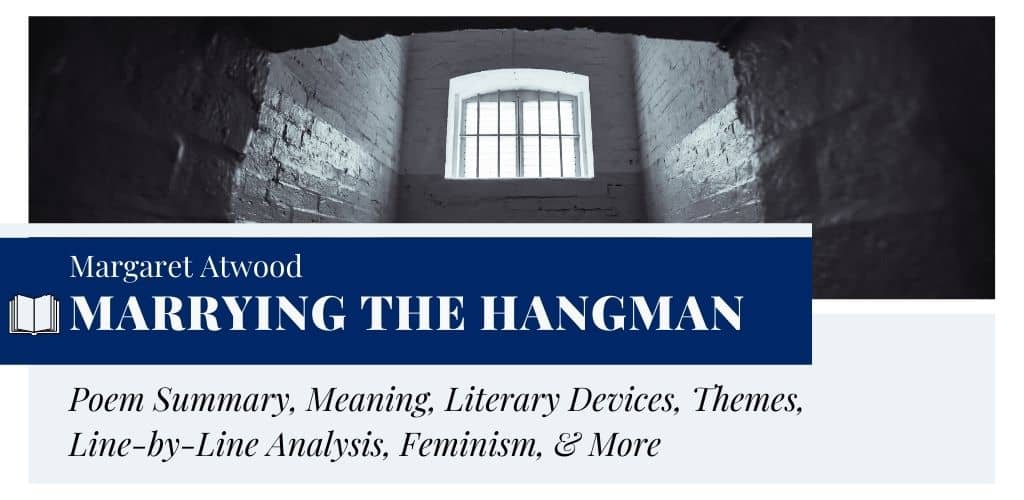Marrying the Hangman by Margaret Atwood
“Marrying the Hangman” appears in Margaret Atwood’s collection of poetry, Two-Headed Poems. This historical poem is about two French prisoners at Québec of the 1750s, Jean Cololère and Françoise Laurent. The former took up the profession of an executioner and the latter married him in order to save themselves from the death sentence. This unconventional love story is discussed in the poem. Atwood provides a better insight into this narrative by fusing imaginary elements. She speculates what might have been in their minds while they decided to marry. Was it purely love or a survival instinct? Probably both?
- Read the full text of “Marrying the Hangman“

Summary
“Marrying the Hangman” is a long historical poem about two prisoners who married in order to be released from a death sentence. This story dates back to 1751 Québec where a man was imprisoned for dueling and a woman was given a death sentence for stealing clothes of her employer. According to Atwood, the latter might have chalked a plan that fit rewarding for both of them. She knew that a man could be free if he became the state’s official executioner and she could free herself by marrying one. There was a vacancy for an executioner at that time so their death was indefinitely delayed. In the meantime, they grabbed the opportunity and in the end, they both were released. This text echoes this historic event with insertions of personal commentaries.
Meaning
The title of the poem presents us two important words, one a “Hangman” and another “marriage”. It gives us a hint regarding the central idea of the poem. Atwood does not retell the story of Jean Cololère and Françoise Laurent. Rather she shows what might be happening in Laurent’s mind while she proposed to Cololère to be an executioner. This piece is told from her perspective that allows readers to ponder upon several questions. The first question that quickly strikes us is the veracity of the 18th-century justice system. Then comes the question of the quality of freedom a woman enjoyed in the past. The last but not least, the text makes us question the very institution of marriage and love.
Structure & Form
“Marrying the Hangman” is a prose poem. It consists of a total of twelve sections. Each section either consists of a long stanza or contains a combination of short, unconventional stanzas. The overall text is written in the form of a narrative story that is embedded with poetic comments. It seems like the poet telling a story to readers and between the breaks she gives her insight into the event.
Besides, the poem does not contain a set rhyme scheme or meter. It is written in free-verse. The speaker of the poem is Atwood’s poetic persona who describes the story of Cololère and Laurent in a combination of third-person and first-person points of view. In most instances, the lines are complete and prosaic. While in some other instances, the lines do not contain an order. These lines contain a number of words separated by the use of commas.
Literary Devices & Figurative Language
Atwood’s “Marrying the Hangman” has the following literary devices.
- Enjambment: It occurs throughout the text. The poet uses a device to internally connect the lines of the long stanzas.
- Irony: This device is used in the very beginning. By using this device, Atwood portrays the discrimination of women in the past. She also uses this device in a number of instances that include the line “This desire in servants was not legal.”
- Repetition: The repetition of words help a speaker to emphasize her point. This piece contains the usage of this device in the first stanza where the term “hangman” is repeated. It is also used in the following stanzas.
- Litotes: It occurs in “This is not fantasy, it is history”. Here, the negative term is used for the sake of emphasis.
- Anaphora: The repetition of similar words at the beginning of successive clauses or lines can be found in the following lines: “To live in prison is to live without mirrors. To live/ without mirrors is to live without the self”.
- Metaphor: The line “This voice/ becomes her mirror” contains a metaphorical comparison between “voice” and “mirror”. It also occurs in the phrase “the impersonal/ mask of death”. Here, a hangman’s “dark leper” is compared to the “mask of death”.
- Rhetorical Question: This device is used to rhetorically pose questions to readers. For example, Atwood uses this device in “Who/ else is there to marry?”
- Metonymy: In the seventh section, the terms said by the characters can be considered as metonyms or symbols for various ideas. The former’s terms are associated with freedom. While the lady’s terms are associated with the idea of physicality and love.
Themes
Margaret Atwood’s poem “Marrying the Hangman” taps on a number of themes that include but are not limited to love, crime and punishment, physicality, freedom, and patriarchy. The overall poem poses a number of questions on the idea of marriage and love. In the 1750s, marriage as an institution shaped the future of women. As in the case of Laurent, she managed to escape death by first creating a hangman and then marrying him. So, for a woman’s survival in society, there was always a man who had the ultimate ruling.
Besides, this piece also makes us think about the oddness of love that can bloom even in the darkest of hours. Where bodies are unable to feel each other or communication is possible only in an unseen, unknown medium, love can flourish. In this way, this piece not only presents us with a historical account of an event but also provides us with a package of themes that are interesting to think upon.
Line-by-Line Analysis & Explanation
Section One
She has been condemned to death by hanging …
… it is history.
The poem “Marrying the Hangman” begins with a reference to Françoise Laurent. Atwood narrates the story of Laurent and Jean Cololère from the point of view of the former. This depiction of history through a woman’s eyes reflects the poet’s feminist ideals. She directly delves into the story with a particular emphasis on Laurent’s death sentence.
In the 18th century, a man might escape capital punishment by taking up the profession of an executioner. While a woman, in the same circumstance, could do so by marrying a man. In this way, Atwood alludes to the backdrop of their story.
At the time of their imprisonment, there was no hangman to execute them. Through the phrase “there is no hangman,” the poet also implies that Cololère was still a prisoner. He had yet to be an executioner. So, their deaths were indefinitely postponed. But, the fear still lingered around them.
In the last line, Atwood emphasizes the fact that it is not an imaginary tale. It is purely a historical event that actually took place in Québec, in 1751.
Section Two
To live in prison is to live …
… her mirror.
In the second section of “Marrying the Hangman”, Atwood digresses from the historiographic details. She uses her imagination in order to portray Laurent’s state of mind. According to her, the lady lived inside the prison walls without any mirrors. She could not see herself or know how she looked. That’s why the speaker says that she was living without the real “self”.
Atwood ironically remarks, for the absence of mirrors she was living “selflessly”. How could she think about herself inside the gloomy prison walls along with the thoughts of imminent death?
Laurent might have found a hole in the stone wall and heard the voice of her co-prisoner. According to loose historical records, Laurent and Cololère were in adjacent cells. So, she could have heard the voice of her future partner.
The voice journeyed through the darkness. It was faceless as she could not see whose voice it was. Somehow they started communicating through this hole and gradually the “voice” became her “mirror”. Slowly, she started to find her lost self again for the presence of another human voice. It was her only hope.
Section Three
In order to avoid her death, …
… there to marry?
The third section progresses further into the story of Françoise and Cololère. Françoise somehow wanted to avoid her death. She was young and filled with the vitality of life. Who does want to die at a young age? So, she tries to chalk a plan even though her neck is wrung in pain and her tongue is swollen with thirst. These images symbolically depict her mental state.
To escape her imminent death, she needed to marry a hangman. But, at that time, there was no hangman. Firstly, she had to create one and persuade the person to marry her. The voice at the opposite side of the wall was promising. Besides, she developed a sensual relationship with the person with whom she had no physical contact. Within them, existed vocal trust.
At the hollow’s end, there was darkness. A completely unknown person whom she had to convince to renounce his actual, human face. He had to wear the “impersonal mask of death” in order to save both of their lives. There was no other way out.
In these lines, Atwood uses metaphors to describe the nature of an executioner’s job. The phrase “impersonal mask of death” depicts death’s faceless, dark visage. It is comparable to the masked face of a hangman. He has the eyes to see others die but not the mouth to voice his feelings. Indeed, such a job is not a piece of cake. It oozes out mercy from his heart.
However, Laurent somehow had to convince him to take up this heartless job. She needed to transform his hands into the firm, undaunted instrument of death so they would not fear to twist the rope tied around one’s throat. She had to twist others’ fate to save her singled-out soul.
Atwood thinks about what else she could do. She could not find another man to marry her except the person whom she had liberated into a hangman.
Section Four
You wonder about her crime …
… This desire in servants was not legal.
In the fourth stanza, Atwood directly addresses readers. They might be speculating about why she was there in the prison. It is astonishing to know that she was condemned to death just for stealing the clothes of her employer’s wife. All she wanted was to make herself presentable. But, at that time, it was a crime that invited capital punishment. Besides, she was a servant. She had no right to look beautiful. On top of that, she was a woman, a voice from the subjugated lower class!
Section Five
She uses her voice like a hand, …
… too is history.
Laurent knew it was her one and only chance for survival. She used her voice to do what her hands could. Her voice managed to reach the other side of the wall where the man with the same fate was imprisoned. It touched and stroked his weary senses and made him realize that there was still hope.
In the following line, the speaker rhetorically asks what Laurent possibly told the man that would have convinced him. She told him about the fact he could be free after being an executioner. But, what was the guarantee that he would marry her? This is the question that troubles our speaker.
Besides, what was the man’s temptation that worked out according to her plan? The speaker thinks of some possible reasons that convinced him to marry the woman who showed him the light. He might have wanted to be with a woman for the rest of his life whom he saved. Alongside that, her voice followed him down into the earth, inside those prison cells but she was not the one who followed him back as other free women would.
He knew it was his only chance to be a hero. If he became a hangman, nobody was going to see him as a hero. They would curse his villainous role. On top of that, he was sentenced to death, not for any Robinhood-like act. He illegally indulged in dueling and wounded another man with a sword. His hands were already stained with blood.
In the last line, the poet reaffirms the fact that all she is talking about is history. There is no tint of exaggeration or fantasy in this story.
Section Six
My friends, who are both women, …
… some of them are unemployed.
The sixth section of “Marrying the Hangman” becomes personal in tone. Here, Atwood digresses from the topic and starts commenting on the story. She compares the event with the contemporary scenario.
Atwood refers to her female friends who tell her stories that she cannot believe or trust. These stories are different from the ones she is telling to readers. Theirs are horror stories that reflect the worsened modern scenario. Besides, such events have not ever occurred in her life.
In the following line, she rejects her statement and says that they have happened to her. But, she has detached herself from such events. Here, the poet is hinting at the history of Canada and the discord between Québec and Canada. She ironically remarks that people watch their unbelief with horror.
Furthermore, she refers to Laurent’s story and says that such events do not happen in broad daylight, especially in modern times. In the following line, one of her friends humorously remarks that though she cannot even see without her glasses, she has no time to put them on.
In the next line, the poet admits the fact that these things happen. She sits along with her friends and speculates about these historical events. They start believing in these stories by telling them over and over to each other. Moreover, the story of Cololère and Laurent is not fantasy. It is history.
Nowadays, there is more than one hangman who has no issues in taking up this ruthless, merciless role. Because of this some of them are unemployed. In this way, Atwood shows how different the past was from the present. Then people were more humane than their modern counterparts. Fortunately, the executioner’s place was vacant at that time. Otherwise, the story would take the usual, tragic turn.
Section Seven
He said: the end of walls, …
… kept their promises.
The seventh section of “Marrying the Hangman” presents a brief conversation between Cololère and Laurent that is filled only with words, ideas, and thoughts. This is purely an imaginary conversation that originates directly from Atwood’s creative mind.
She thinks Cololère might have shown his future partner the ends of the walls where freedom awaited. The end of ropes that he needed to pull to execute. But, the job could be a ticket for their collective freedom. By the following words, “field”, “wind”, “house”, “sun”, “table”, and “apple” the poet tries to paint a picture of family, togetherness, and their married life.
The lady might have shown him her body through sounds. She told him about her body and the things they were going to have. Besides, they could look into the depths of one another’s eyes. Then the communication would be more spiritual, soundless, than their vocal communion. In the end, they both kept their promises.
Section Eight
The hangman is not such a bad …
… choice.
Where history fails to dictate future proceedings of an unrecorded event, the mind of an artist penetrates. It finds our the unknown annals of some faded records and present us, the readers, a beautiful story, created purely out of imagination. “Marrying the Hangman” is a manifestation of this imagination process of Atwood.
In this section, she thinks of their life beyond the prison walls. The hangman is not that bad in her thoughts. He goes to the refrigerator and cleans up the leftovers. However, he does not wipe up what he accidentally spills as he does as an executioner. His job is to execute not to clean up other’s faults.
He needs only simple things like a comfortable chair to rest his back. He needs someone to pull off his shoes after he returns from his work. Everyone needs a partner to look at while talking or sharing intimate thoughts. He needs such a wife who will look at him with admiration and fear. If she is grateful, it would be an added benefit.
Besides, his body needs the warm touch of a female companion who would soothe his senses and renew his desires. According to the speaker, these things are the added benefits of marrying a woman like Laurent who was condemned to death by patriarchal society for the simple wish to be beautiful!
Section Nine
Everyone said he …
… the word ensnare.
Society, as usual, was not pleased with their story. Everyone said Cololère was a fool to trust a person, particularly a woman. They were of the view that the lady was indeed clever. She knew how to play her cards as she did in her servant’s house. They used the word “ensnare” to define her plan. She rather trapped a gullible prisoner to regain her freedom?
Section Ten
What did they say the first …
… forever.
The tenth section is filled with a series of rhetorical questions. These questions speculate over the story further and provide further inputs to readers. She asks what society said the first time they were alone in the same room. Furthermore, she asks what the hangman said when she removed her “veil”, a metaphorical reference to her plotting.
This line further delves into carnal depths. On the day, she undressed, the hangman might have seen that the voice had a body, rather a beautiful, promising body. But, she was finite like any other woman, unable to fulfill a man’s hunger.
In the next line, the poet thinks of what the hangman’s wife actually discovered after marriage. She was rather outsmarted by the fact that she had left the locked prison for another. Whatsoever, the poet thinks they indeed talked about love as it is a natural instinct in human beings. But, these feelings did not last to keep them busy forever.
Section Eleven
The fact is there are no stories …
… according to the law.
In this section of “Marrying the Hangman”, the poet shares an ironic fact. She tells readers that there are stories in history that can make her feel better. There are dark sides that are often ignored. For instance, in the hangman’s story, thoughtful readers can find several disturbing ideas about society, justice, and the place of women.
This darker side of history cannot ever be erased. One can only ease the tension by mere speculation. In the next line, the poet talks about the role of women in the 18th century. At that time, there were no female hangmen. If there have been any, no man could save his life by marrying her. Then, he may feel the same as Laurent. The irony lies in the fact that a woman could save herself through the grace of a hangman, laid down by law created by none other than males.
Section Twelve
He said: foot, boot, order, city, …
… kept their promises.
The last section of the poem presents us with another conversation of the apparent lovers. Through this conversation, it can be guessed that here the speakers are talking about their past. The hangman might have tried to provide a glimpse at his past life. His sentence is not complete and contains only references to a wide array of symbols.
Likewise, the lady’s statement contains some interesting symbols. For instance, the terms “water” and “night” hints at her past troubles. While the terms “rope hair” and “earth belly” symbolically portray her physical features. The last terms are associated with the profession of a hangman.
At last, Atwood tells readers that they both adhered to the promises they made to each other.
Feminist Analysis of Marrying the Hangman
In “Marrying the Hangman” a feminist poem? The answer starts to bloom from the very title itself. It questions the institution of marriage. Not only that, it presents us with another side of the justice system of the past. Then, a female prisoner who was sentenced to death needed to marry a hangman and be freed. Atwood alludes to this law to hint at the role of women in society. On top of that, stealing, which is regarded not as a major crime, was punishable by death then. The case became more promising if it was a female offender. Further down the text, Atwood shows readers different shades of love and marriage. She portrays how the concept of freedom, beauty, and free will vary in the case of women. In this way, she projects her feminist ideas impregnated within rhetorical questions.
Historical Context
Margaret Atwood’s “Marrying the Hangman” appears in her eighth book of poetry Two-Headed Poems. It was published in 1978. The collection contains a cycle of poems concerning a pair of Siamese twins. In this collection, readers can find metaphors for Canada and internal strife. For instance, in “Marrying the Woman,” she presents readers with some probing questions fusing them into the historical narrative of Jean Cololère and Françoise Laurent. Cololère was a resident of New France who was sentenced to death for illegal dueling. Laurent, whose theft attracted her capital punishment, convinced him to become a hangman and marry her in order to save both of their lives. This piece is based on the account of 1751.
Other Notable Works
Besides Atwood’s “Marrying the Hangman,” several notable writers also explored the story of Cololère and Laurent. These include the short historical drama film The Hangman’s Bride by Naomi McCormack, Kate Cayley’s play The Hanging of Françoise Laurent, etc. You can also check out the following works:
- The Hangman in the Mirror by Kate Cayley
- Marrying the Hangman: A True Story of Privilege, Marriage and Murder by Sheila Weller
Questions & Answers
Margaret Atwood’s “Marrying the Hangman” explores the historical story of two residents of New France, Jean Cololère and Françoise Laurent. They were both sentenced to death. In order to save their lives, Cololère became an executioner and Laurent married him.
“Marrying the Hangman” alludes to a true account of 1751. It took place in Québec, New France. This story is about two prisoners Jean Cololère and Françoise Laurent who wisely save their lives by marrying each other.
The poem appears in Margaret Atwood’s poetry collection Two-Headed Poems. It was published in 1978.
Similar Poems about Love & Feminism
- “Bequest” by Eunice de Souza — This piece explores the lives of women in a conventional, patriarchal society.
- “The Survivor” by Marilyn Chin — This poem describes what a girl faces in her family as well as in society.
- ‘I’m “wife” — I’ve finished that —’ by Emily Dickinson — In this poem, Dickinson talks about the frustration of living an eclipsed life in a male-dominated world.
- “My True Love Hath My Heart” by Sir Philip Sidney — This conventional love poem is about two lovers’ devotion to each other.
External Resources
- Check out Two-Headed Poems (1978) by Margaret Atwood — Explore this best-known poetry collection of Atwood. Here, you can find far more interesting poems like “Marrying the Hangman”.
- About Jean Cololère & Françoise Laurent — Learn about the interesting love story of Cololère and Laurent.
- Biography of Margaret Atwood — Read about one of the best-loved Canadian poets, Margaret Atwood’s life and her works.
- Poet Profile & Poems of Margaret Atwood — Explore more about the poet and read her best-known poems.





